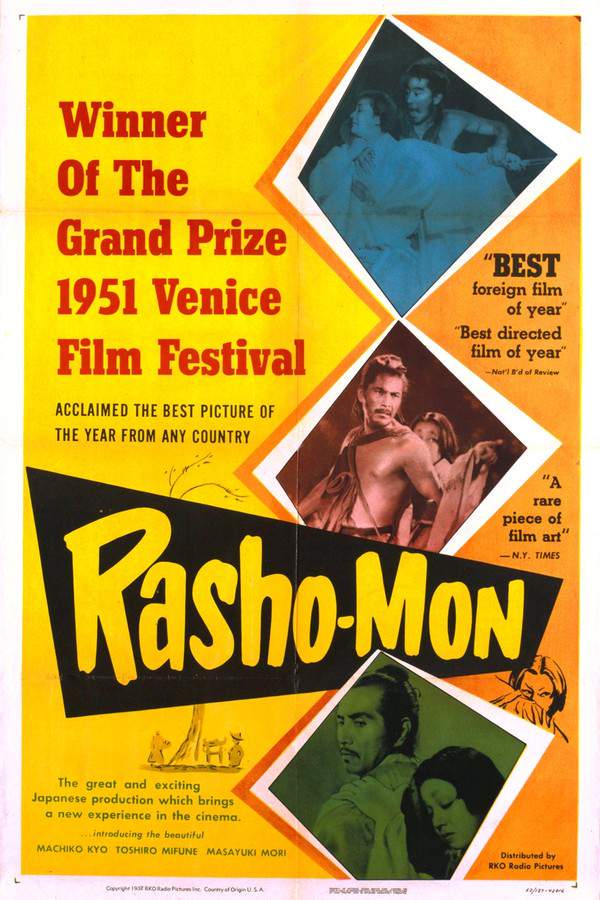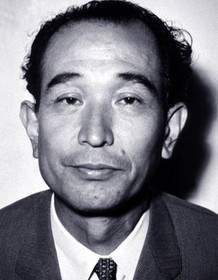
Rashomon 1951
Directed by

Akira Kurosawa
Made by

Daiei Motion Picture Company
Rashomon Plot Summary
Read the complete plot summary and ending explained for Rashomon (1951). From turning points to emotional moments, uncover what really happened and why it matters.
Sheltering from a rainstorm, a woodcutter, played by Takashi Shimura, and a priest, portrayed by Minoru Chiaki, find themselves in the ruins of the Rashomon gatehouse, pondering the shocking tale they recently encountered at a murder inquiry in a nearby courthouse. Their conversation is interrupted when a commoner, played by Kichijiro Ueda, expresses a keen interest in hearing the unsettling details of the story that has deeply disturbed the priest. The priest laments the incessant disasters of life, stating that despite the countless tragedies he has witnessed, nothing could prepare him for the horror of this particular account. The woodcutter, bewildered by the events surrounding the murder, hopes that the commoner can assist him in unraveling this perplexing tale.
The woodcutter takes the lead in narrating his experience from three days prior, when he ventured into the mountains in search of firewood. As he walked through the forest, the sunbeams danced through the leaves, casting intricate patterns of light and shadow. His exploration leads him to discover a woman’s hat ensnared in a bush, followed by a samurai’s hat and pieces of rope. It is only when he stumbles upon something partially hidden in the leaves that he realizes he has tripped over a corpse. In a panic, he drops everything—including his axe—and flees to report his findings to the authorities, leading him to the courthouse to testify days later.
In a sunlit courtyard, the woodcutter recounts to the court that he was the first to find the body. When questioned about any weapons or pertinent items, he insists he discovered nothing but the hats and a shiny amulet case, hinting at significant details: the rope’s placement near the body and the amulet’s distinctive red lining.
As the narrative unfolds, the priest recounts a sighting from three days earlier, where he saw a samurai, played by Masayuki Mori, traveling with a woman, beautifully portrayed by Machiko Kyô, on a horse, equipped with a sword and bow. This reflection prompts a poignant consideration of life’s fleeting nature, stirring sympathy for the widow now overwhelmed with grief.
The policeman, depicted by Daisuke Katô, appears next, providing testimony that identifies the captured bandit, Toshirô Mifune, renowned as Tajomaru. The policeman shares the moment of his capture and the circumstances surrounding the murder, suggesting Tajomaru fell from the stolen horse during his escape.
Contrary to the policeman’s narrative, the bandit vehemently denies any wrongdoing, asserting that he merely sought a drink from a spring and insists he knows his fate is sealed. With a bold declaration, he confesses to the murder of the samurai, weaving an extravagant tale of how he initially intended to abduct the woman without harming her husband. Through the bandit’s testimony, presented with bravado yet tinged with arrogance, we catch glimpses of his animalistic nature, highlighted by his carelessness and fly-swatting antics.
As the bandit’s story progresses, it includes details of how he ambushed the samurai under the pretense of leading him to a hidden cache, ultimately binding him and luring the wife into the same trap. In an unexpected twist, the woman surprises both men with a fierce attack, though she ultimately succumbs to the bandit’s charm. Following a passionate and conflicted moment, she desires a duel, challenging the men to settle their fates. This request ignites a fierce but chaotic sword fight, culminating in the samurai’s demise at the hands of the bandit.
Amidst the courtroom drama, the wives’ emotional unraveling serves to highlight her vulnerability and tragic predicament. In a heart-wrenching confession, she reveals that after the bandit’s assault, she found herself at a pond, where memories blur as she grapples with the aftermath of violence and betrayal.
The tales continue to intertwine as different perspectives emerge, revealing layers of manipulation and hidden truths, all leading to a confrontation of moral ambiguity. The woodcutter, witnessing these varying accounts, ultimately grapples with his own recollections of that fateful day. After observing the bandit’s desperate pleas for the woman to join him, and her subsequent rejection, he shares a crucial piece of information that casts doubt on the integrity of the testimonies presented.
In the Rashomon gatehouse, after much debate and skepticism, the commoner and the priest confront the harsh realities of human nature, revealing a society steeped in dishonesty and self-preservation. The commoner cynically points out the inherent flaws in humanity, suggesting that perhaps goodness is merely an illusion we grasp in our attempts to cope with uncomfortable truths.
As the rain begins to let up, a baby’s cry from the wild prompts a profound moment of connection between the woodcutter and the priest, revealing their underlying humanity. Despite the woodcutter’s admission of his minor theft, the priest recognizes the goodness within him and, in a heartfelt exchange, they symbolically reconnect with a sense of faith in mankind. The woodcutter departs into the emerging sunlight, embodying a glimmer of hope amidst the lingering shadows of doubt.
Rashomon Timeline
Follow the complete movie timeline of Rashomon (1951) with every major event in chronological order. Great for understanding complex plots and story progression.
The Rainstorm
As a rainstorm begins to pour, a woodcutter and a priest take refuge in the ruins of the Rashomon gatehouse. Their desperate shelter sets the stage for a strange and horrifying story that will unfold about a recent murder.
The Woodcutter's Discovery
Three days earlier, the woodcutter ventured into the mountains to gather firewood. While walking through the woods, he stumbles upon a corpse hidden among the leaves, which sends him running to report his disturbing find to the police.
The Testimony Begins
In the courthouse garden, the woodcutter testifies about his discovery of the body. He claims he found nothing but a few hats, ropes, and an amulet case, inadvertently revealing key details that will shape the investigation.
The Priest's Witness
The priest shares his account of seeing the samurai just days before his death, riding along the road with a woman. His testimony reflects on the nature of life and death, as he expresses sorrow for the tragedy.
The Bandit's Capture
The policeman reveals that he captured the notorious bandit, Tajomaru, two days prior. In a vivid recollection, he describes how the bandit was found writhing by a riverbank, emphasizing the chaotic nature of the events surrounding the murder.
Tajomaru's Version
Tajomaru admits to killing the samurai, recounting the events with a bravado that diminishes as the details emerge. He explains how jealousy drove him to harm the samurai after tricking the wife into being emotionally vulnerable.
The Duel Proposal
In a shocking turn, the woman demands that the men duel to the death after the bandit has incapacitated her husband. This leads to a fierce and tense sword fight, highlighting the chaotic conflict among the characters.
The Woman's Despair
The woman recounts her own harrowing experience, revealing the emotional turmoil she faced amidst the violence. After her husband's death, she attempts suicide, expressing her deep remorse and despair over the tragic events.
The Samurai's Spirit
A medium performs a ritual, channeling the voice of the deceased samurai. His testimony is filled with sentiments that contradict the woman and the bandit's stories, painting a complex picture of love and betrayal.
The Woodcutter's Secret
The woodcutter reveals, with hesitance, that he witnessed the fatal encounter from a distance. He claims the truth of the murder doesn't align with either story presented, challenging the credibility of the testimonies he has heard.
The Commoner's Cynicism
As tensions rise, the commoner expresses his disillusionment about human nature, questioning the honesty of those involved. His remarks about morality resonate amidst the conflicting accounts of the murder.
The Abandoned Baby
The group hears the cry of an abandoned baby, prompting a further discussion on morality and responsibility. The woodcutter finds himself confronted with his own shortcomings as he reflects on human decency.
A Moment of Redemption
Despite their earlier doubts and conflicts, the woodcutter and the priest find a moment of understanding. The priest hands the baby to the woodcutter, marking a small but significant act of faith in humanity.
A Journey into the Sunlight
As the rain finally stops, the woodcutter walks away from the Rashomon gatehouse, feeling a sense of resolution. His journey into the sunlight signifies a glimmer of hope in a world clouded by darkness and deceit.
Rashomon Characters
Explore all characters from Rashomon (1951). Get detailed profiles with their roles, arcs, and key relationships explained.
Woodcutter (Takashi Shimura)
The woodcutter is a complex character, torn between his moral compass and his desire for self-preservation. Initially depicted as a humble worker, his hidden truths and conflicted conscience reveal a depth of character that adds to the narrative's ambiguity. His final actions highlight the struggle between complicity and integrity in a world rife with deception.
Priest (Minoru Chiaki)
The priest embodies a voice of reason amidst chaos, wrestling with his faith in humanity as he bears witness to the unfolding testimonies. His internal struggle with doubt and despair reflects the larger themes of morality and truth. He often offers philosophical insights, seeking to reconcile the darkness he observes with the hope of goodness.
Bandit (Toshirô Mifune)
The bandit is a charismatic yet morally ambiguous figure who oscillates between bravado and vulnerability. His conflicting testimonies reveal a complex inner life, where his desires and egotism clash with the consequences of his actions. He serves as a catalyst for the events, representing the raw instincts of survival and desire.
Samurai (Masayuki Mori)
The samurai is depicted as both a victim and a tragic figure, embodying the struggle for honor in a world that threatens to strip it away. His interactions with the bandit and his wife reveal the complexities of loyalty and love, driving the story towards its poignant climax. His silent demeanor speaks volumes about the weight of societal expectations.
Woman (Machiko Kyô)
The woman is a tragic figure whose actions are driven by desperation and social constraints. Her duality is evident as she navigates her emotions towards both men, culminating in a powerful yet ambiguous portrayal of femininity. Her narrative highlights the challenges women faced in a patriarchal society, raising questions about agency and victimhood.
Rashomon Settings
Learn where and when Rashomon (1951) takes place. Explore the film’s settings, era, and how they shape the narrative.
Time period
The events occur in a late feudal period of Japan, characterized by warfare and social strife, impacting the characters' moral decisions and perspectives. This era often reflects the struggle between honor and dishonor, which plays a crucial role in the story's unfolding events. The societal tension and the quest for truth resonate throughout, shaping the characters' interactions.
Location
Rashomon gatehouse, Mountains, Courthouse garden
The story unfolds in the ruins of the Rashomon gatehouse, an ancient structure that symbolizes moral ambiguity and the complexity of truth. Set against the backdrop of serene mountains, the lush woods contrast sharply with the dark events that occur within them. The courthouse garden serves as a pivotal location where testimonies are given, highlighting the intersection of nature and human conflict.
Rashomon Themes
Discover the main themes in Rashomon (1951). Analyze the deeper meanings, emotional layers, and social commentary behind the film.
🔍
Truth
The central theme revolves around the elusive nature of truth, as witnessed through the conflicting testimonies of the characters involved in the murder. Each perspective reveals personal biases and deeper truths about human nature, prompting the audience to ponder the reliability of one's account. The film forces the viewer to question the very essence of truth and its perception in human society.
💔
Betrayal
Betrayal is a pervasive theme, represented through personal relationships and societal interactions. The characters grapple with loyalty and deceit, leading to tragic outcomes that stem from their actions and choices. The emotional turmoil caused by betrayal underscores the fragility of life and trust between individuals, marking pivotal moments in the narrative.
❓
Human Nature
The exploration of human nature is prominent as the characters reveal their instincts of self-preservation, jealousy, and fear. This theme plays out through the varying accounts of the same incident, illustrating how individuals manipulate narratives to protect themselves or to justify their actions. The film prompts viewers to reflect on the darker aspects of humanity and the reasons behind moral failings.
Featured on this page

What's After the Movie?
Not sure whether to stay after the credits? Find out!
Explore Our Movie Platform
New Movie Releases (2025)
Famous Movie Actors
Top Film Production Studios
Movie Plot Summaries & Endings
Major Movie Awards & Winners
Best Concert Films & Music Documentaries
© 2025 What's After the Movie. All rights reserved.




